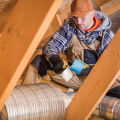When it comes to energy efficiency and environmental friendliness, duct sealing services can be a great way to reduce your carbon footprint. By ensuring that your air conditioning system is running efficiently, you can save energy and help protect the environment. The Environmental Protection Agency (EPA) recommends that you read up on the subject of duct cleaning before making any decisions. While there is no conclusive evidence that cleaning air ducts will prevent health problems, it is important to note that dirty air ducts are just one of many possible sources of particulate matter in homes.
Pollutants from both outdoor and indoor activities, such as cooking, cleaning, smoking, or just moving around, can cause greater exposure to pollutants than dirty air ducts. Before cleaning, reconditioning, or replacing the ducts, the cause or causes must be corrected, or else the problem is likely to reappear. Some research suggests that cleaning the components of the heating and cooling system may improve system efficiency. However, there is little evidence that cleaning only the ducts will have any effect.
If you decide to have your air ducts cleaned, it's important to make sure that the service provider agrees to clean all components of the system and is qualified to do so. The EPA does not recommend that air ducts be cleaned routinely, but only when necessary. The EPA also recommends that if you have a furnace, stove, or fireplace that burns fuel, they be inspected for proper functioning and maintained before each heating season to protect against carbon monoxide poisoning. As long as cleaning is done properly, there is no evidence to suggest that such cleaning is harmful.
You may want to consider cleaning your air ducts simply because it seems logical that the air ducts will get dirty over time and should be cleaned from time to time. Whether you decide to clean your home's air ducts or not, preventing water and dirt from entering the system is the most effective way to avoid contamination. If you decide to clean your heating and cooling system, it's important to make sure that the service provider agrees to clean all components of the system and is qualified to do so. In addition, the service provider may propose the application of chemical biocides designed to remove microbiological contaminants inside ducts and in other components of the system.
Some service providers may also suggest applying chemical treatments (sealants or other encapsulants) to encapsulate or cover the inner surfaces of air ducts and equipment housings because they believe they will control mold growth or prevent the release of dirt particles or fibers from the ducts. These practices have not yet been thoroughly investigated and you should be fully informed before deciding to allow the use of biocides or chemical treatments in your air ducts. They should only be applied, if at all, after the system has been properly cleaned of all visible dust or debris. On the other hand, if family members have unusual or unexplained symptoms or illnesses that you think might be related to your home environment, you should discuss the situation with your doctor. The EPA has published several publications for guidance on how to identify potential indoor air quality problems and ways to prevent or fix them. In conclusion, while there is no conclusive evidence that regular duct cleaning will provide any environmental benefits, it may be worth considering if you think your air ducts are dirty. However, it's important to make sure that any service provider agrees to clean all components of the system and is qualified to do so.



